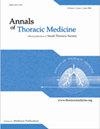重症肌无力在胸腺瘤中的临床人口学特征和预后作用:来自沙特人群的经验
IF 2.3
4区 医学
Q3 CARDIAC & CARDIOVASCULAR SYSTEMS
引用次数: 0
摘要
摘要:目的:本研究的目的是确定重症肌无力(MG)在胸腺瘤中的临床人口学特征和预后作用。方法:回顾过去23年来费萨尔国王专科医院和研究中心胸腺瘤手术切除患者的记录。最终纳入70例胸腺瘤患者,然后根据MG状态分为MG组(39例)和非MG组(31例)。收集的数据包括患者的人口学特征、肿瘤特征和术后临床结果。所有分析均使用SPSS进行。两组间的比较分别采用学生t检验和卡方检验对连续变量和分类变量进行检验。P = 0.05及以下为有统计学意义。结果:患者年龄11 ~ 76岁,女性居多(55.7%)。与非mg组相比,患者性别差异无统计学意义(P = 0.058);而MG患者年龄较小(39.30 vs 48.77, P = 0.0095)。根据世界卫生组织(World Health Organization)分级,两组间无差异(P = 0.398),但根据TNM分级,MG患者倾向于肿瘤进展较慢(P = 0.039),根据MASAOKA分级系统,MG患者倾向于肿瘤进展较慢(P = 0.017)。肿瘤大小(P = 0.077)、可切除性(P = 0.507)、辅助治疗(P = 0.075)均无显著变化。MG与术后并发症、发病率或死亡率无显著相关性。然而,在较低的复发率(2.56% vs. 35.48%, P = 0.0001)和较长的生存期(18.62 vs. 10.21年,P <0.001),与非mg患者相比。结论:MG在胸腺瘤患者中更容易发生在年龄较小、TNM分级较高和MASAOKA晚期。虽然MG与并发症和死亡率之间没有明显的关联,但MG通过提供较低的复发率和较长的生存时间,在胸腺瘤中表现出保护作用。本文章由计算机程序翻译,如有差异,请以英文原文为准。
Clinicodemographic characteristics and prognostic role of myasthenia gravis in thymoma: Experience from a Saudi population
Abstract: OBJECTIVES: The objectives of the study were to determine the clinicodemographic characteristics and the prognostic role of myasthenia gravis (MG) in thymoma. METHODS: The records of patients who underwent surgical resection of thymoma at King Faisal Specialist Hospital and Research Center in the past 23 years were reviewed. Seventy thymoma patients were finally included and were then categorized based on MG status into the MG group (39 patients) and the non-MG group (31 patients). Collected data included patients’ demographic characteristics, tumor characteristics, and postoperative clinical outcomes. All analyses were conducted using SPSS. The comparison between both groups was tested using the Student t -test and Chi-square test for continuous and categorical variables, respectively. A P = 0.05 or less indicated statistical significance. RESULTS: Patients’ age ranged from 11 to 76 years, and female predominance was observed (55.7%). Compared to the non-MG group, no difference in patients’ gender was observed ( P = 0.058); however, MG patients had a younger age (39.30 vs. 48.77, P = 0.0095). No difference was noted between both groups based on the World Health Organization classification ( P = 0.398), but MG patients tended to present with less-advanced tumors based on the TNM classification ( P = 0.039) and lower stage based on the MASAOKA staging system ( P = 0.017). No significant change in tumor size ( P = 0.077), resectability ( P = 0.507), and adjuvant therapy ( P = 0.075) were observed. MG was not significantly associated with postoperative complications, morbidity, or mortality. However, it exhibited a prognostic protective role in terms of lower recurrence (2.56% vs. 35.48%, P = 0.0001) and longer survival duration (18.62 vs. 10.21 years, P < 0.001) as compared to non-MG patients. CONCLUSIONS: MG occurrence in thymoma patients is more likely to occur at a younger age, higher TNM classification, and advanced MASAOKA stage. Although no significant association was noted between MG and complications and mortality, MG exhibited a protective role in thymoma by providing a lower recurrence rate and longer survival duration.
求助全文
通过发布文献求助,成功后即可免费获取论文全文。
去求助
来源期刊

Annals of Thoracic Medicine
CARDIAC & CARDIOVASCULAR SYSTEMS-RESPIRATORY SYSTEM
CiteScore
4.10
自引率
4.30%
发文量
19
审稿时长
>12 weeks
期刊介绍:
The journal will cover studies related to multidisciplinary specialties of chest medicine, such as adult and pediatrics pulmonology, thoracic surgery, critical care medicine, respiratory care, transplantation, sleep medicine, related basic medical sciences, and more. The journal also features basic science, special reports, case reports, board review , and more. Editorials and communications to the editor that explore controversial issues and encourage further discussion by physicians dealing with chest medicine.
 求助内容:
求助内容: 应助结果提醒方式:
应助结果提醒方式:


